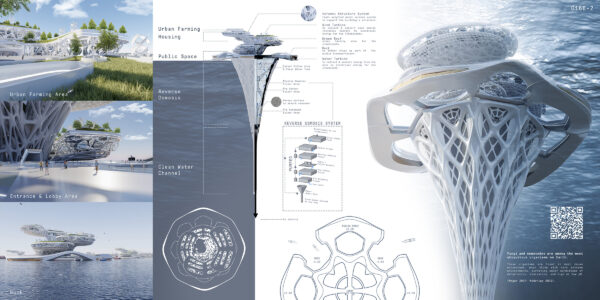Honorable Mention
2022 Skyscraper Competition
Christopher Tanihaha, Vincentius Kevin Aditya, Arnetta Hamijoyo, Christina Putri Larasati, Evan Januar, Gavrila Mandy Kahuni, Eugenia Jessica, Felia Alexandra Linoh, Luciana Augusta, Gregorius Christian, Reynaldi Daud
Indonesia
Sinking land has become inevitable. It is mainly caused by the increase of seawater level and got worse by the decreasing underground water table that is happening simultaneously. Sinking land causes land scarcity which makes coastal residents around the world lose their homes. According to BBC News in 2018, the fastest-sinking city in the world in Jakarta, Indonesia. Jakarta is sinking by an average of 1-15cm a year and nearly half the land now sits below sea level. The dramatic rate of sinking is partly down to the excessive extraction of groundwater for drinking water and everyday hygiene purposes by city dwellers. Piped water is not reliable and hardly available in most areas so people have no choice but to resort to pumping water from the aquifers deep underground. So the main goal is to be a buffer that acts as a vessel for ex-dwellers of the sinking city that also provides potable water for the remaining citizens on land at the same time.
Our project here helps achieve this goal with two approaches. Firstly, the submerged zone provides water supply for the people of Jakarta by filtering seawater through a reverse osmosis system. This process starts with the seawater entering the building through a pump directly attached to the pre-sediment filter zone. The seawater then gets filtered once again using carbon and then passed through a membrane to conduct reverse osmosis. Reverse Osmosis works by using a high-pressure pump to increase the pressure on the salt side of the RO and force the water across the semipermeable RO membrane, leaving almost all the dissolved salts behind in the reject stream. Clean water gets distributed to the dwellings above, and some get transferred back to the city of Jakarta to supply the remaining residents so there will be no need to extract more groundwater for everyday purposes. Second, the floating zone provides living space for the citizens who lost their homes.
The submerged and floating zone connects to one another creating a fungi-like platform for the dwellers. As fungi are known to be able to thrive even in the worst circumstances, Fung(s)i also aimed to be able to sustain the worst environmental challenges possible. This project uses a modular configuration that makes it possible to be built in any part of the world and uses the Voronoi structure which takes after aesthetically pleasing features and structural objects found in nature. This structure divides the space into smaller spaces organically. It also creates a natural pattern in the building’s facade and saves more space in the building itself. The Voronoi cells also contribute to energy saving, since it allows natural light inside the building.
As its main goal is to stall the complete submergence of the city before the citizens have the chance to escape, it has contributed to sustaining countless aspects such as environmental by omitting the need to pump potable water from underground and social-cultural-economic by creating a new living “ground” to sustain humanity in the future.

















